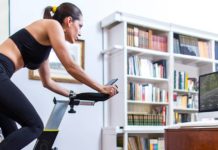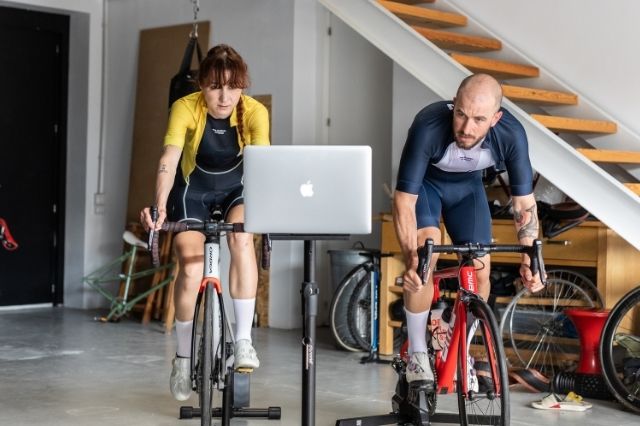On the web we have already talked about the benefits of indoor cycling. This time we are going to see what are the main differences between indoor and outdoor cycling.
If you have never trained on a trainer before and you start using it, you will notice two things: it is harder and you sweat a lot. Training on a trainer has become an indispensable tool for cyclists and triathletes, but it has several differences with outdoor cycling.
You sweat a lot more
Undoubtedly, one of the big differences between indoor and outdoor cycling. As a general rule, inside a room the temperature is higher than outdoors, this is one of the factors that cause you to sweat more.
Sweating is the main method of cooling the body, through sweat lowers the temperature. The problem is that when training outdoors the body regulates temperature much more easily due to the contact of sweat with the air. At home there is no air that can help cooling.
In addition, it is important to keep an eye on your hydration because we can lose a lot of fluid through sweating and cause the blood to lose fluidity, which causes the heart rate to increase.
More demanding
Training on a Smart trainer is widely considered to be harder than trainer outdoors. When you train within four walls, there are no downhills or moments of relaxation. You always have to pedal, unlike when you train on the road.
Another point that makes it more demanding is the inertia. When you go at 35 kilometers per hour on the road and you stop pedaling the bike doesn’t stop, but on a trainer if you stop pedaling the bike stops and it’s hard to get back up to speed. Currently, there are increasing attempts to alleviate this with inertia disks.
Body posture
When you don’t train within the four walls you constantly modify your posture. The different conditions of the environment make you constantly have to rectify your posture to make a climb or pass a bump.
On the trainer, your posture is always the same. If you have a bad posture, it is possible that you will not change it for a long time, so it is necessary to have good biomechanics.
Balance is not involved, since you are static you don’t need to condition your body in case there is a curve. You also don’t need to have as good proprioception of the body as in road cycling.
Attention
While training, paying attention to your thoughts about the exercise you are performing causes you to have a higher sense of effort. By not being distracted on the trainer we think much more about the workout itself.
Being distracted while training reduces the feeling of effort, which is why apps to compete and distract yourself while training on the trainer are becoming so important.
Points in favor of indoor training
Although you may think that being more demanding is a negative point for the trainer, in fact, the opposite is true. Training on the trainer will make it seem easier when you get out on the bike.
It allows you to have thorough control of metrics without interference that you can have on the road. You’ll be able to better control your watts when training.
You are not dependent on the weather. By training within four walls it doesn’t matter what the weather is like outside, you can train, even if it’s raining outside. You don’t take risks. Dangers are minimized, there is no traffic and there is no chance of falling while training due to a sudden movement, so it is safer.













